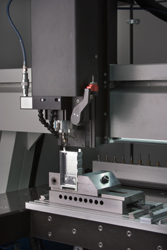Micromechanical influences on sintering green parts
The current trend in material processing is to develop manufacturing methods for near-net shape products. Among the environmentally acceptable processing technologies, powder metallurgy is considered the most promising for realising the full economic potential of near-net shape forging of complex automotive parts. The PM-MACH project, supported by the FP5's GROWTH Programme, has developed effective techniques for compacting metal powders when placed in a closed metal cavity under pressure. Powder compacts, which are referred to as 'green' parts, are then heated in a protective atmosphere at a high temperature to form a solid close to the desirable shape. To improve the accuracy in the powder compacts' dimensions and minimise the secondary finishing operations, project partners at the Institut National Polytechnique de Grenoble used finite element (FE) simulations. In combination with appropriate material constitutive laws, they were able to describe the evolution of the microstructural characteristics, including the size distribution of powder particles as well as of pores. Moreover, the final shape could be predicted and the mechanical properties characterised more accurately than ever thought possible. More specifically, the green parts' deformation during sintering is highly anisotropic as a result of the inhomogeneous internal structure. For this purpose, an anisotropic constitutive equation was formulated on the basis of information obtained by dilatometry and X-ray absorption micro-tomography, among other techniques. Containing several material parameters that need to be estimated from experimental data, it is yet simple enough to be implemented in any finite element simulation code.



